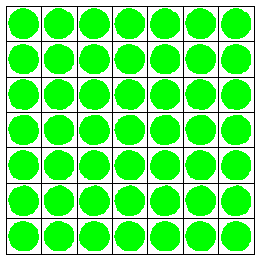The story goes that when Carl Friedrich Gauss (1777–1855) was 10 years old, his teacher gave the pupils in an arithmetic class the problem of summing the integers from 1 to 100. Gauss came up with the answer almost immediately: 5050. He had found it by noting that the sum consists of 50 pairs of numbers, where each pair sums to 101.

In effect, Gauss had discovered a simple method for summing an arithmetic sequence (or arithmetic progression). In an arithmetic progression, each term is calculated from the previous one by adding (or subtracting) a constant value. To get the sequence’s sum, multiply the number of terms by the average of the smallest and largest terms.
This famous story testifies to Gauss’s mathematical precocity as a child. It’s repeated—with variations and differing amounts of detail—in many textbooks, articles, and Web pages. Math teachers often tell it to their students.
One particularly detailed account is in the biography Gauss: Titan of Science by G. Waldo Dunnington. Long out of print, the book has recently been republished by the Mathematical Association of America. It’s considered the most comprehensive biography of Gauss available in English
Dunnington provided all sorts of details. The teacher was J.G. Büttner, director of the St. Katharine’s Volksschule. The school seems to have had a medieval flavor—dingy surroundings and teachers ready to use the whip to encourage learning.
“Büttner once gave the class the exercise of writing down all the numbers from 1 to 100 and adding them,” Dunnington wrote. “The pupil who finished an exercise first always laid down his tablet in the middle of a big table; the second laid his on top of this, and so forth. The problem had scarcely been given when Gauss threw his tablet on the table and said in Brunswick low dialect: ‘Ligget se‘ (There ’tis).”
There are many other variants of the story. Some accounts insist that the teacher assigned the problem just to keep the class busy (and quiet) for a long period so he could take a break.
Intriguingly, E.T. Bell’s account of Gauss’s life in his 1937 book Men of Mathematics suggests that the problem Gauss faced wasn’t actually as simple as summing the integers from 1 to 100.
“As it was the beginning class none of the boys had ever heard of an arithmetical progression,” Bell wrote. “It was easy then for . . . Büttner to give out a long problem in addition whose answer he could find by a formula in a few seconds. The problem was of the following sort, 81297 + 81495 + 81693 + . . . + 100899, where the step from one number of the next is the same all along (here 198), and a given number of terms (here 100) are to be added.”
That’s a tougher problem, and it’s possible to imagine that it would take “ordinary” pupils a long time to solve it.
Just as in Dunnington’s version, Bell described Gauss as completing the problem very quickly and flinging down his slate.
“Then, for the ensuing hour, while the other boys toiled, he sat with his hands folded, favored now and then by a sarcastic glance from Büttner, who imagined the youngest pupil in the class was just another blockhead,” Bell wrote. “To the end of his days Gauss loved to tell how the one number he had written was the correct answer and how all the others were wrong.”
When details differ among various accounts, which story should you believe—and retell? Does it even matter?
In the mathematics classroom, it may be worth taking a little bit of extra trouble to get the facts right or, at least, to be as precise as possible. After all, mathematics is built on proof and precision. Aiming for the same standard in mathematical anecdote isn’t really too much to ask, even when you can’t be sure of the facts and simply have to admit upfront that a story may not be completely true.
Puzzle of the Week
There were 49 trees in an orchard, arranged so that there were seven rows, with seven trees in each row (see diagram, above). The gardener decided that the orchard was too crowded. He called in a worker and ordered: “Leave only five rows of trees, with four trees in each row. Cut down the rest and take them home for firewood as your payment for doing the work.”
When the tree cutting had finished, the gardener came to see the result. Much to his dismay, he found the orchard had only 10 trees left instead of the 20 trees he had expected.
“Why have you cut down so many? You were told to leave 20 trees!” the gardener shouted.
“No,” the worker replied. “You told me to leave five rows with four trees in each row. I did so. Just look.”
The gardener was amazed to find that the 10 remaining trees formed five rows with four trees in each row. How had the worker done it?
For the answer, go to http://www.sciencenewsforkids.org/articles/20041013/PuzzleZone.asp.






